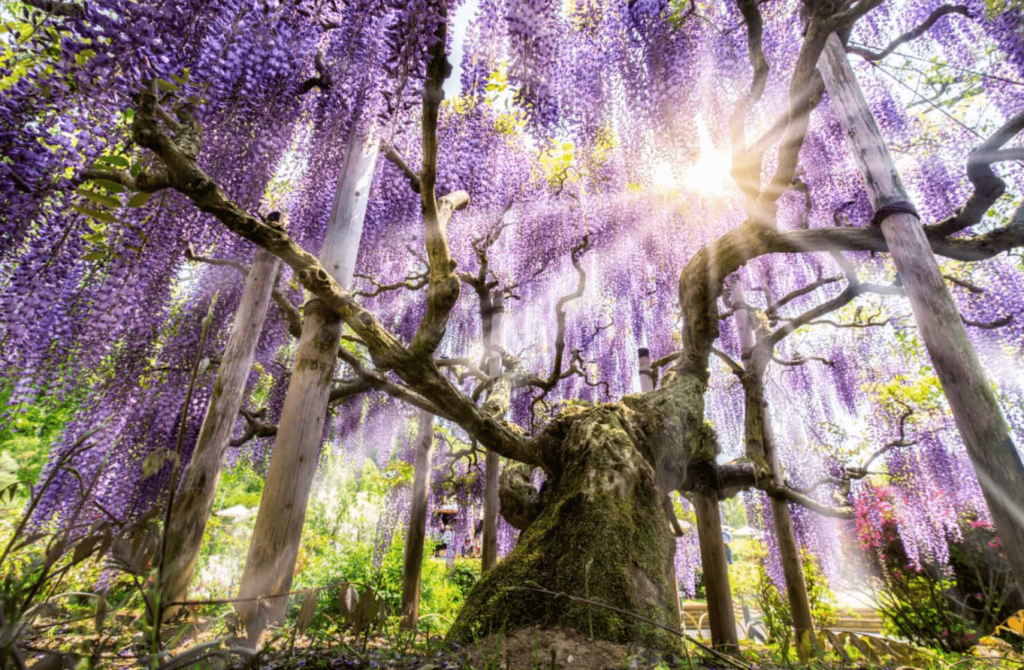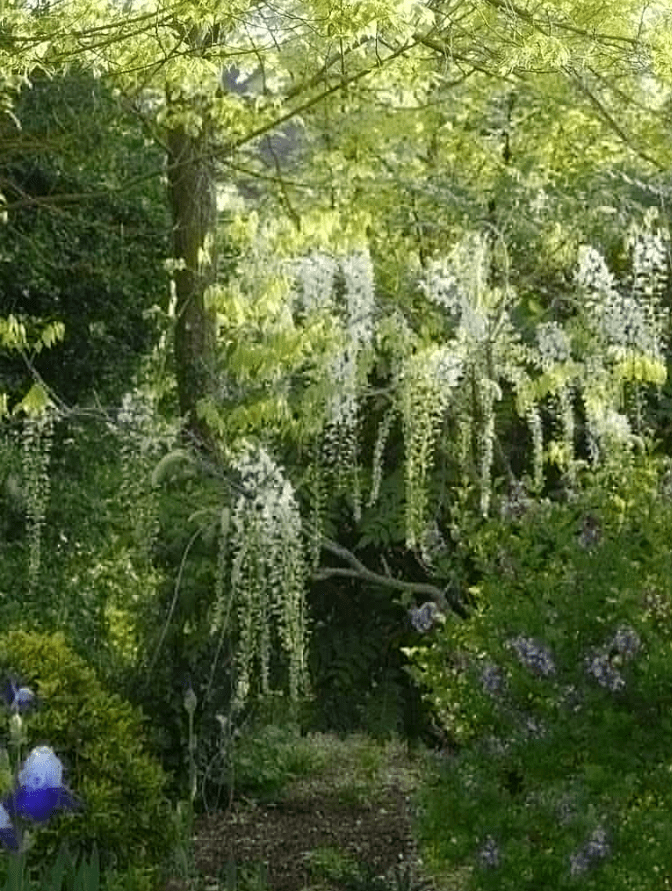A small masterpiece It attracts the attention of everyone who sees it. It combines artistic expression with horticultural skills. This post explores the history. Care and techniques for developing this extraordinary work of living art. As we explore the allure of the stunning wisteria bonsai tree. The Wisteria bonsai tree originates from the East and has a cultural heritage spanning centuries. This smaller version of the larger model is a beautiful symbol of harmony between humans and nature. It has been painstakingly designed and perfected over time. You will learn about the complicated steps in growing wisteria bonsai as you delve deeper into the subject. Every step of development requires unwavering dedication and meticulous attention to detail. From choosing the perfect seeds to learning proper pruning and training skills. Alright, let’s go!
Table of Contents
Common Types of Wisteria Bonsai Trees
Beautiful and much sought after ornamental plants. Visperia bonsai trees add elegance and beauty to any yard or living room. They are a favorite choice among bonsai lovers for their beautiful vines and brilliant flower arrangements. There are many types and varieties of wisteria bonsai trees. And each plant has special properties that make it a small miracle. This is more interesting and interesting.
Chinese Wisteria (Wisteria sinensis)
One type of bonsai that is widely planted is Chinese wisteria. Famous for its stunning appearance and fast growth. fragrant lavender flowers. The blue or white flowers are arranged in long, hanging flowers on this plant. Its small, delicate leaves form foliage that provides a beautiful backdrop for flower arrangements. Although Chinese wisteria trees need to be trained and pruned periodically to maintain their ideal shape, these stunning flowers are well worth the effort.
Japanese Wisteria (Wisteria floribunda)
Another popular choice among bonsai lovers is Japanese wisteria. It has long rows of flowers in dazzling shades of purple, blue, pink and white. This is an interesting bonsai technique because of its unique flowers and strong branches. Careful pruning and walking of this breed is necessary to achieve the desired artistic form while maintaining health and vigor.
American Wisteria (Wisteria frutescens)
Although less widespread in bonsai culture than other Asian varieties, American wisteria is native to the southeastern United States. And it’s a great choice. This is due to its more compact growth habit and shorter branch size. Therefore, American wisteria is a good choice for small bonsai projects. The fragrant flowers are usually lavender or pale blue. Gives a pleasant aroma to the surrounding air.
Silky Wisteria (Wisteria venusta)
An interesting form called silk wisteria originates from China. Also called Wisteria venusta or Wisteria brachybotrys, the silvery hairs on the new growth give it a fluffy appearance. This is its most distinctive feature. Shorter, denser wisteria flowers include white, blue, or purple flowers. It is considered the top of tender wisteria. This plant is prized for its lush blooms and low maintenance requirements.
Double-Flowered Wisteria

Among wisteria there are many species and varieties. Wisteria with double flowers is a visually striking type. By providing flowers that have many layers of petals. The distinctive characteristics of Bonsai make it stand out and attract attention when it is in full bloom. These striking trees are prized by gardeners for their aesthetic value. Because it gives a scent of majesty to your bonsai collection.
Caring For Your Wisteria Bonsai Tree
Beautiful tree Wisteria bonsai trees are prized for their abundant flowers and graceful vines. They need to be well cared for to maintain their health and attractiveness.
Placement and Sunlight
Your wisteria bonsai should be placed in a place with lots of sunlight. A location that gets at least six hours of sunlight each day is ideal for these plants because they prefer direct, strong sunlight. If you choose to keep your bonsai in your home, make sure it gets enough light by placing it next to a south-facing window or under a lamp.
Watering
Water your wisteria bonsai regularly. Make sure the soil is evenly moist but not soggy. To determine the amount of moisture in the soil Insert your finger about 1 inch in. Watering is necessary if it feels dry. Make sure not to disturb the roots or soil by using a gentle stream of water.
Pruning
An important part of maintaining wisteria bonsai is pruning. Prune long growth and new branches frequently. To create a bonsai of the desired size and shape. when the plant is not developing actively This usually occurs in late winter or early spring. Pruning should be done during the dormant season.
Wiring and Training
Creating your wisteria bonsai requires some training and wiring. To guide branches carefully to the right place. Use soft copper or aluminum wire. Because wisteria branches are delicate Therefore, be careful when applying too much pressure. Make sure the cable is not cut by branches by checking it frequently. and make any necessary adjustments or deletions.
Fertilizing
Fertilize your wisteria bonsai during the growing season to keep it alive and healthy. Use a balanced, water-soluble fertilizer at all times. two to three weeks This is to give the tree time to relax during the dormant season. Reduce or stop adding fertilizer.
Repotting
Repotting is necessary for Wisperia bonsai trees every two to three years to replenish the soil and prevent the roots from becoming overcrowded. New planting is most effective in early spring. before new growth appears When moving to a new pot Prune roots carefully to encourage new development and maintain a compact root structure.
Pest and Disease Control
Watch out for diseases and pests that can damage your wisteria bonsai. Aphids, spider mites, and scale insects are common pests. If you encounter problems Take quick action using vegetable oil or insecticidal soap.
Winter Care
Move your wisteria bonsai to a shady location for the winter. Or cover the pot with mulch or a plastic cover to protect it from the bitter cold. During this time Water the plant sparingly as its growth will slow down.
Pruning Your Wisteria Bonsai Tree
Wisteria bonsai trees require regular pruning to maintain their shape. Promotes good growth and produces lots of flowers Use these detailed instructions to prune your wisteria bonsai properly.
1. Choose the Right Time for Pruning
When Wisteria Bonsai Goes Dormant This usually occurs in late winter or early spring. This is the best time to prune branches. By pruning now, the plant can utilize its energy for recovery and new growth will occur when it is time to plant.
2. Prepare Your Tools
Gather the tools needed to prune wisteria bonsai. If you want to prune precisely without damaging the branches, you will need sharp pruning shears or scissors. to stop the spread of disease Make sure your equipment is clean and hygienic.
3. Identify Dead and Diseased Branches
Check your wisteria bonsai first for diseased or dead branches. These branches will appear brittle. Discolored or dry To maintain the general health of the plant and stop the spread of disease, the plant must be removed.
4. Look for Overcrowded Branches
Then look for branches that grow too big, blocking ventilation and sunlight. Overcrowded areas can become infected with mold and lose overall structural integrity. so the canopy can expand Prune these branches carefully.
5. Trim Back Long Shoots
Wisteria is famous for its rapid growth. And the long shoots have the ability to quickly outgrow the bonsai form. To make your wisteria bonsai the size and shape you want. Cut off these long shoots. Carefully cut the area above the leaf node to encourage new growth in the desired direction.
6. Encourage Flowering
Reducing some of the side shoots on the main branch of your wisteria bonsai will help it produce more abundant flowers. By focusing the plant’s energy on the surviving buds. This mechanism produces more flowers throughout the blooming season.
7. Shaping the Canopy
Visualize the shape you want your wisteria bonsai to be, then carefully prune branches to achieve it. Use the “pinch and plant” method to allow the plant to spread naturally before pruning it back. Get the desired shape
8. Regular Maintenance
When caring for wisteria bonsai Pruning is a continuous process. Check your bonsai often. to view new growth and make necessary shape adjustments You can ensure the long-term health and optimum condition of your wisteria bonsai by pruning it regularly throughout the year.
9. Dispose of Pruned Branches Properly

Make sure to properly dispose of cut branches after pruning a wisteria bonsai. This will prevent potential infections from spreading throughout the bonsai. Take them out of the pot and dispose of them by throwing them away or composting them.
Common Problems with Wisteria Bonsai Trees
Like other plants Growing a wisteria bonsai tree is a pleasure. But there are some obstacles that must be overcome. It is important to understand common problems and how to fix them to maintain the well-being and beauty of your wisteria bonsai.
Poor Flowering
Your wisteria bonsai is not blooming at all or not blooming as much as you thought.
There are many reasons why a wisteria bonsai may not bloom well. Make sure your bonsai receives enough sunlight. Too little light will reduce the number of flowers. Heavy leaves can be caused by too much nitrogen fertilizer. But flowering may decrease. A phosphorus-enriched fertilizer formula stimulates flowering. Adjust the fertilizer. Proper pruning is also important. If you want to have more flowers Trim off any excess growth and trim off any side shoots. Be patient, as some types of wisteria take several years to mature and grow quickly.
Pest Infestations
Pests such as spider mites, scale insects, and aphids attack your wisteria bonsai.
Check your bonsai often. To see signs of pest infestation Take immediate action if an infestation is detected. Aphids and spider mites are examples of small pests that can be eliminated with a strong spray of water. Use neem oil or insecticidal soap according to the manufacturer’s instructions to prolong the infestation. Keep your bonsai healthy and well cared for. Healthy, well-growing plants are more resistant to insect attack.
Diseases
Symptoms of disease on wisteria bonsai include wilting, leaf spots, and fungal growth.
Many diseases can be prevented with good care techniques. Make sure that the soil around Make sure your bonsai has good drainage to prevent the soil from becoming soggy, which can cause the roots to rot. Avoid soaking the leaves when you water the plant from the base up. Remove infected leaves and branches to prevent the disease from spreading. during cutting Disinfect your pruning tools to prevent the spread of germs. Severe fungal infections can be treated with fungicides. But to keep your bonsai healthy, you must avoid it above all else.
Root Issues
Your wisteria bonsai is showing signs of root problems, such as wilting, poor growth, and yellowing leaves.
Check your bonsai’s root structure regularly. Planting a new bonsai will encourage good root growth if you notice root clumping or roots wrapping around the container. When newly planted Cut off damaged or curled roots. Make sure the pot has enough holes for drainage. and add a soil mix that drains efficiently. Don’t overwater as too much moisture can cause the roots to rot. during watering Let the soil dry out a little.Wisteria Bonsai Tree: Complete Care & Growing Instructions

